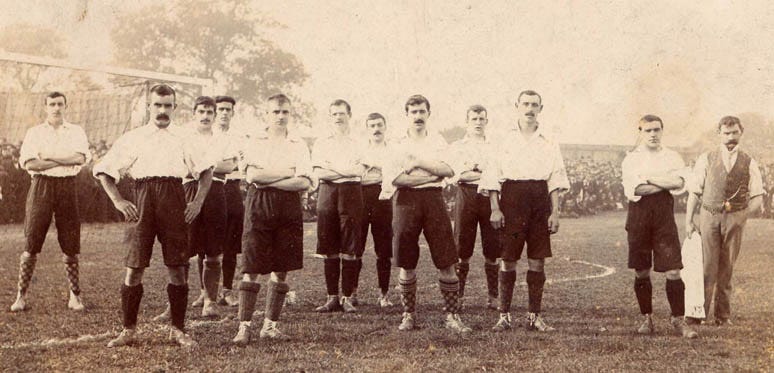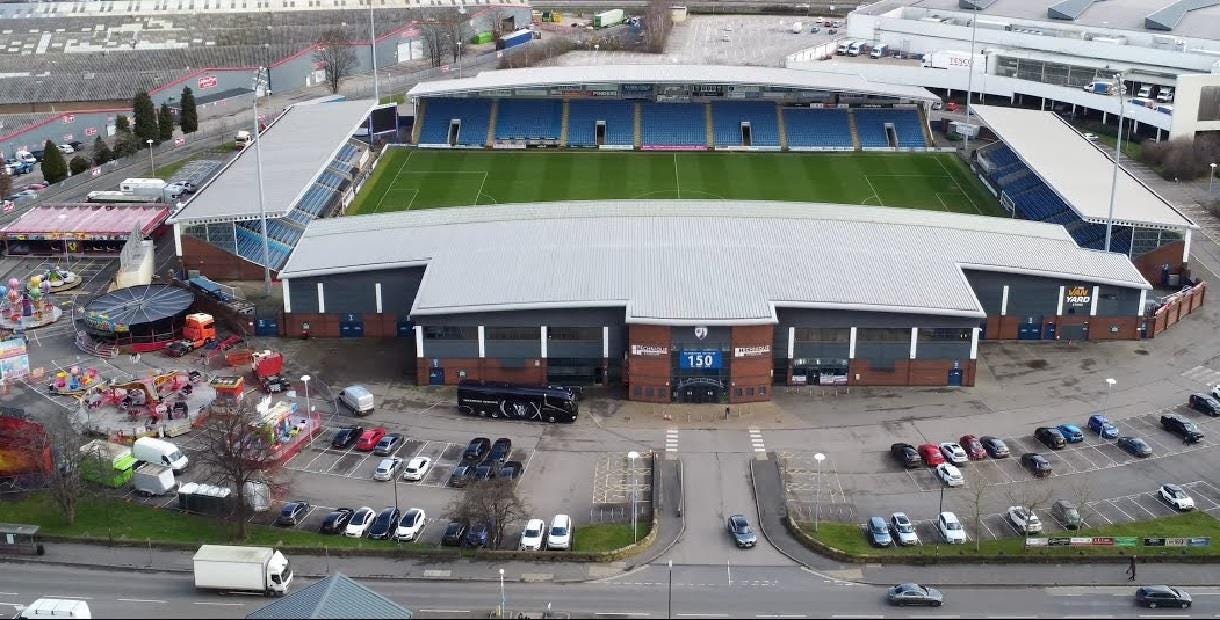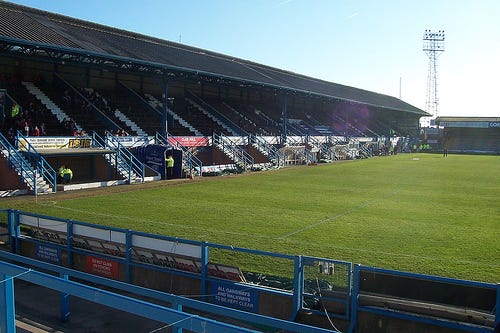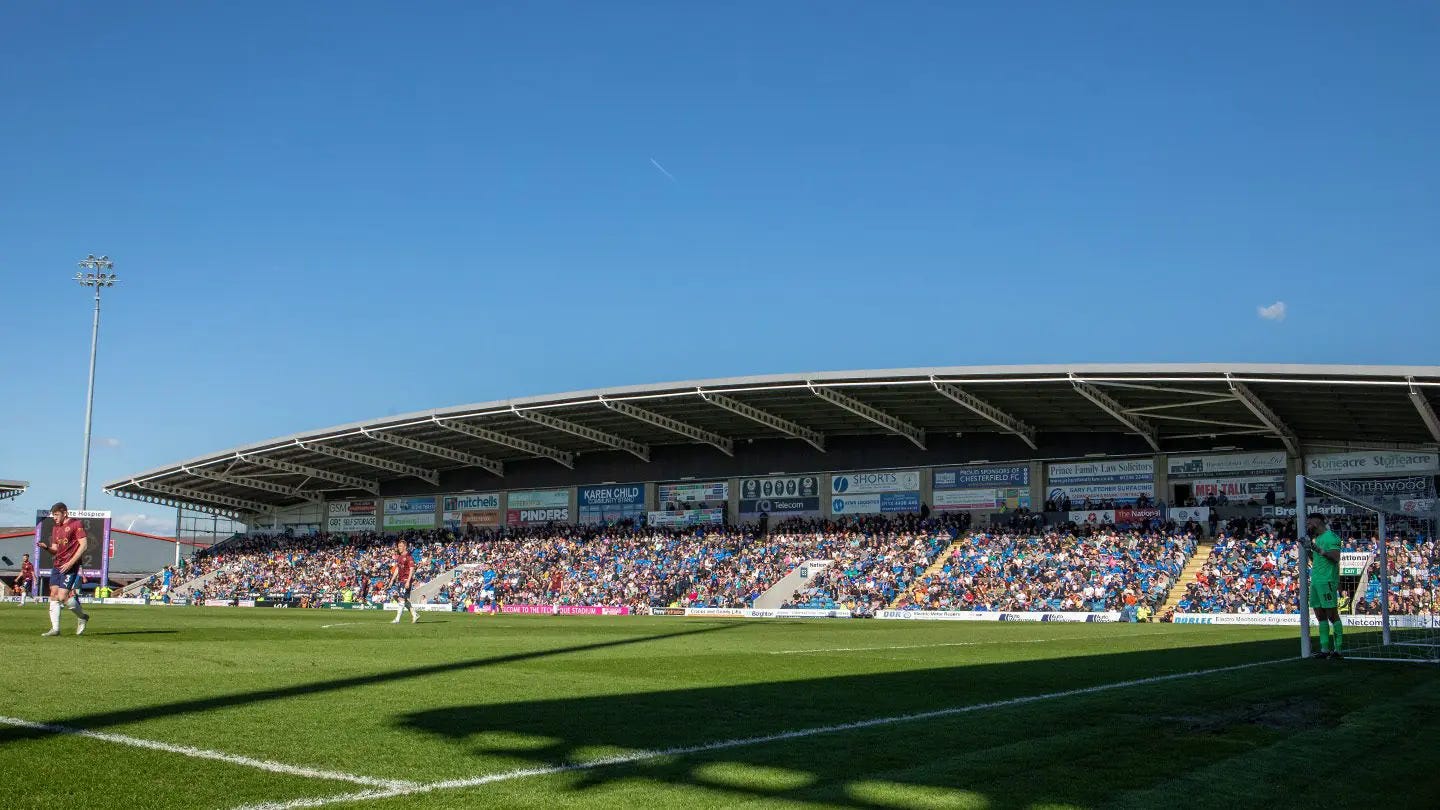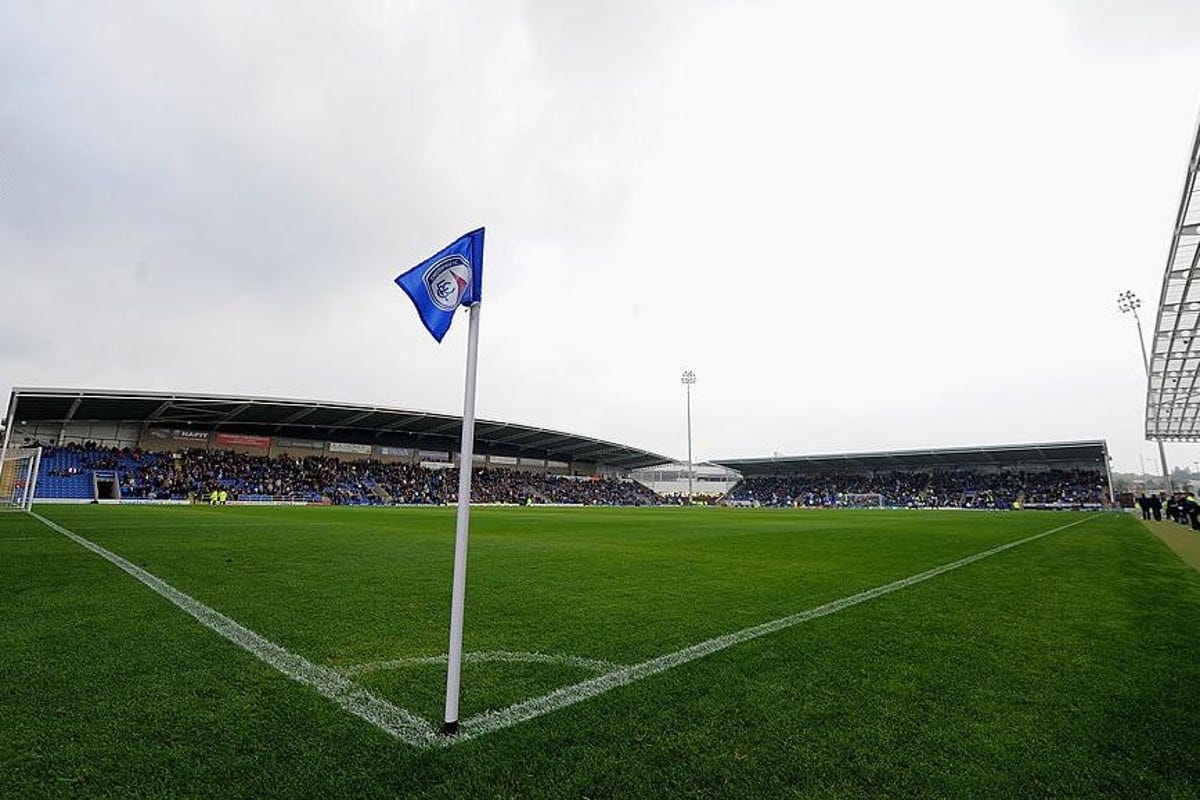Stadium Report: SMH Group Stadium (Chesterfield)
In which there are daylight fireworks and the most hated bell ever
Stadium architecture goes through phrases like everything else. There are good eras, and then are are bad eras. The 1990s and 2000s were definitely a bad era, maybe one of the worst. Not because of terrible design or the stadiums not being fit for purpose. Definitely not. No, the problem was how bland they were. Because so many teams decided to get new stadiums for a relatively little outlay because their current grounds were falling apart, architects offered cut and paste designs. That meant in the UK at least, lots of stadiums with very similar designs were built in the 2000s. I’m thinking of the likes of Pride Park and Riverside as the main culprits, but you can name a lot more that came about after them. But when do things start to turn? I say that because in the 2010s, architects realised the dull monstrosities they were creating and decided to bring back a bit of flair. So when did that happen? Well, we might have an answer.
I am proposing that the answer lies in Chesterfield, a place that’s in Derbyshire but a lot of people think it’s in South Yorkshire. It’s the town that’s most famous because they couldn’t build a church spire properly and instead of admitting it, blamed the fact a devil jumped into it after being mis shod by a local blacksmith. And there’s only one professional club here, Chesterfield FC. They were not the first club in the town or even the first team called Chesterfield FC. Heck, there’s at least five Chesterfield FCs before the one we know now was formed, and Chesterfield do claim a formation date of 1866, though there is record of a Chesterfield side facing a Norton in 1864. The current club was formed in 1919, a few years after a Chesterfield Town was disbanded due to illegal payments. It was created by the council to try and promote recreation in the town and was initially named as Chesterfield Municipal, but the FA weren’t particularly happy with a government body owning a club. Thus, a year later they would become independent from the council, meaning the Liberal Democrats can’t send leaflets to residents saying the council has spent too much money on a new striker. This is also when it would be renamed as Chesterfield FC.
For many decades, the history of Chesterfield is not that remarkable. They mostly floated around the Third and Fourth Divisions with the odd great player coming from them, notably Gordon Banks. They did however become everyone’s favourite team for a year when they stunningly made the FA Cup semi-finals in 1997. They faced Middlesbrough with a place at Wembley on the line. And even more amazingly, Chesterfield looked like they were going to do it. Vladimir Kinder was sent off for Boro, and goals from Andy Morris and Sean Dyche had the Spireites 2-0 up. Fabrizio Ravenelli got one back for Middlesbrough and then the controversy that can still spark a riot in this part of the world happened. Jon Howard got the ball in the box and smashed it towards goal. It bounced off the bar, down onto the ground and then back out of again. Howard was off celebrating and TV replays showed it was across the line. Just a shame a then that the referee didn’t think it had gone over, even with his linesman giving it. Chesterfield would not extend their lead and Middlesbrough were able to force a replay which they’d win. While that team remain heroes in Chesterfield, there’s still plenty of anger and upset over what could have been.
Since then, Chesterfield have been through the customary terrible owner with a chairman Darren Brown getting the club a points deduction for trying to get away with not paying for Luke Beckett. He’d end up in prison for fraud. Dave Allen was also chairman for a time and as a Sheffield Wednesday fan, I have no nice things to say about him. Not long after people a couple of games away from being promoted to the Sky Bet Championship after getting into the League One play-offs, things starting going downhill. Dave Allen antics affected the on the pitch product and the Spireites would drop down the leagues and then out of the league altogether. They have found out how tough it is to get out of the National League after years of battling to get out, only to be foiled by a combination of Ryan Reynolds and Macauley Langstaff last year.
Right now, Chesterfield play at what is known as the SMH Group Stadium. But they are better known for playing at Saltergate. It was originally known as the Recreation Ground when one of the Chesterfield iterations moved into it as it was just down the road from the cricket club they split off from. Over the years, several different Chesterfield sides played at the ground before the current one was formed in 1919. For a while, the new Chesterfield were going to play at a new stadium at the Queen’s Park cricket ground but it would cost too much, so instead they headed to Saltergate. Over the decades they’d develop the ground, with Archibald Leitch even building a stand at the stadium. Due to the board taking their time with the construction of them, Saltergate would be the second to last ground in the league to have floodlights, installing them in 1967, four years after they had actually been bought. That doesn’t seem like a bright idea in hindsight.
It seems like during the entire life of Saltergate, there was talk about Chesterfield moving to a new stadium. This started to ramp up in the 1980s and the talk would get intensified following the Valley Parade fire and then the Taylor Report following the Hillsborough Disaster. The main idea was to move to a site on Wheeldon Mill where the greyhound stadium was and this seemed to be something on the movie following the closure of the dog races. But just as Chesterfield were getting planning permission to get a stadium on this site, the local council popped up saying they wanted to regenerate the A61 corridor. That meant there was an ideal site on the old Dema Glass factory, something the club had previously considered but then moved on from due to the cost. The club and council agreed to a new stadium on this site in 2005 and in 2010, the new stadium was completed. Chesterfield would go all out with it’s goodbyes, and David Niven scored a last minute winner to give the ground a storybook ending. Anyone who still wants to experience Saltergate after it’s demolition in 2012 can watch The Damned United, the Brian Clough biopic where Saltergate stands in for The Baseball Ground as they had a similar look. By that, both were rusty.
In 2010, Chesterfield’s new stadium was opened as the b2net Stadium. It has had several sponsorships since then, I internally always think of it as the Proact Stadium, and is currently the SMH Group Stadium. I only found out it was called this when doing my research for this article, which further proves the point of football finance experts who say each subsequent stadium sponsorship becomes less effective. It’s not just been a home ground for Chesterfield in it’s 10+ years of existence, it’s also hosted several England youth matches and concerts. Lionel Ritchie, Tom Jones and Elton John have all performed here. Having legends like this come to your town must be such a massive thing for a town like Chesterfield that often gets caught in the shadow of both Derby and Sheffield.
For this visit, Chesterfield were out in the sunlight being watched by the country because their match against Portsmouth in the FA Cup was being broadcast on ITV Sport. I took a dirt cheap train from Sheffield (£4.50 return!) and then walked about 30 minutes from the station to the ground via a footpath that runs parallel to the A61. When you approach the ground, alarm bells will be setting off for groundhoppers. Anytime you have to walk through a retail park to get to the stadium, you do worry you’re about to come across a dull, identikit stadium without no soul. Yes, it’s nice to have a KFC before the game, get a Costa to walk in with and then pick some groceries from Tesco on the way out. But it doesn’t usually indicate a gem of a ground. The grey exterior also doesn’t suggest greatness. There is however a Memorial Garden at the back of the East Stand, which is a lovely way to pay tribute to Spireites who are no longer with us.
However, getting in the ground does change your mind and banish the alarm bells away. I was in the East Stand for this game and there was some initial annoyance. I was in FS6, but there is no signage pointing to which gangway to go to so you can feel a bit lost. Thankfully, the seat numbers don’t reset to it was easy to work out where I was meant to be. When inside, you see that this is not just a boring reproduction. There has been some thought and flair put into the construction, mostly with the curved roof. Apparently, the club says the curve on at least one of these stands is actually an optical illusion, but I think they are wrong. It makes the ground visually different at least, even if it isn’t the most remarkable design. It’s also not a bowl, with each stand being separate. It again just makes the stadium feel a bit more like it’s own thing rather than just something you could buy out of a catalogue. This became a very nice break to some of the dull bowls being built by several of Chesterfield’s rivals and considering the improvement in stadiums since, showed other teams you can break from the pack.
It would end up being a fun game too. Chesterfield fans flocked in to see a chance of an upset and plenty had come from the south coast too. It was a great atmosphere, and someone in the local neighborhood decided to let off fireworks to celebrate it. At the very least, it seems like the only reason I can think of to let a firework off at 12:30pm. And no, it’s not drugs because if you, someone who is spending their spare time reading a stadium report, knows that tells you illegal drugs are for sale, so do the police and dealers aren’t that daft. The only problem with the atmosphere was that a Portsmouth fan decided to bring along a bell and ring it as if there was a wedding about to start. It was possibly the most irritating sound I’ve heard at a stadium, and I heard the Kop Band every week when I was a Sheffield Wednesday season ticket holder. My thoughts were summed up by a fan near me shouting they’d like to shove the bell up their arse
.
Before the end of the first half, the home fans were given the opportunity to celebrate like mad. A free kick was headed in by Tom Naylor, giving Chesterfield a deserved lead on the balance of play. In the second half, the Spireites should have extended their lead but weren’t able to grab another goal. I’ll tell you something, that Armando Dobra should not be playing in the National League, he is way too good for that level. But in the end, what mattered was that Chesterfield did not concede another goal. This meant they got the win, caused an upset against Portsmouth and their name is in the next round of the FA Cup. They were drawn against Leyton Orient. Leaving the stadium was as simple as getting in, done relatively easily and with no overcrowding like you’d expect at a modern stadium. Whether that fan got his wish and shoved the bell up the Portsmouth’s fan’s arse remains unconfirmed.
This might seem like a bit of an unremarkable stadium but I think it’s a bit of a trend changer. For the years before this, stadiums were very cookie cutter, dull and personalityless. We’ll come across plenty of them as this series continues. But I feel like the SMH Group Stadium proved a bit of a point. I’m not going to say this is an architectural stunner or anything like that, because it isn’t. But it went against the grain of bland bowls with it’s curved roofs and individual stands and showed you can make something with a bit of character on a smaller club budget. Stadiums have generally got a lot better over the last decade with architects finally realising that these grounds can be massive stunning monuments. I think in it’s own small way, this stadium helped change our course onto this path.




